Top News
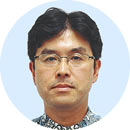
November 29, 2011 Ryukyu Shimpo
When asked why Defense Minister Yasuo Ichikawa has not gone any further than saying, “The government is preparing to submit the environmental impact report to the prefecture before the end of the year,” and why Ichikawa avoids giving a clear schedule for the submission of the report on the environmental impact of the planned relocation of the facilities at Futenma to Henoko in Nago, Satoshi Tanaka, the chief of the Okinawa Defense Bureau said, “Would you say, ‘I am going to commit an act against you,’ before you commit an act against someone?”
He allegedly used a term that is often interpreted as implying an act of sexual violence against women.
Tanaka also stated his opinion that while the government plans to submit the report before the end of the year, it will give consideration to the feelings of the Okinawan people.
In the context of Okinawa Prefecture’s strong demands for the relocation of Futenma Air Station outside of the prefecture, and the fact that the Okinawa Prefectural Assembly has unanimously decided to ask the central government not to submit the evaluation report on the environmental impact of the relocation of Futenma Air Station to Henoko, this indiscreet comment by Tanaka, suggesting a contempt for human rights and disdain for the Okinawan people and for women, could attract a backlash.
Tanaka attended a gathering for the media hosted by the Okinawa Defense Bureau at a tavern in Naha. Staff from about 10 news companies from both within and outside the prefecture participated.
In response to a question about why Ichikawa has not given a clear statement with regards to the schedule for the submission, Tanaka said, “Would you say, ‘I am going to commit an act against you,’ before you commit an act against someone?”
When contacted by the Ryukyu Shimpo after the gathering at the tavern, a spokesperson of the Okinawa Defense Bureau said, “We are not in a position to confirm or deny that the comment was made.”
With regards to the U.S. military bases in Okinawa, remarks indicating disdain for women have caused controversy in the past.
At a press conference in November 1995, after three U.S. military personnel had kidnapped a 12 year-old Okinawan girl, beaten and raped her on September 4 that same year, U.S. Navy Admiral Richard C. Macke, the commander of the United States Pacific Command at the time of the rape, said: “I think it was absolutely stupid. I have said several times: for the price they paid to rent the car [used in the crime], they could have had a girl [prostitute].” Macke ended up being dismissed from his post and forced into early retirement.
Tanaka was born in 1961. He graduated from Osaka University where he studied in the Faculty of Law and went on to become a member of the staff of the Defense Facilities Administration Agency in 1984. He took up the post of chief of the Okinawa Defense Bureau after serving as head of the Facility Planning Section of the Facilities Department of the Naha Defense Facilities Administration Bureau, the head of the Publicity Unit of the Minister’s Secretariat and the head of the Planning Section of the Bureau of Local Cooperation.
Although Tanaka made this remark in an unofficial meeting with reporters, the Ryukyu Shimpo newspaper decided that it was in the public interest to report it.
(English Translation by T&CT, Mark Ealey)
Go To Japanese

November 23, 2011 Yukito Kinjo, correspondent of the Ryukyu Shimpo
In the 2011 Okinawan Islands Fair held from November 25 at Okinawa Cellular Park Naha Ie Rum Santa Maria of the Ie Island Product Center (headed by village mayor Katsumasa Oshiro) was selected as a local product of superior quality. The rum also received the prefectural governor’s award, which is the highest award, at the 14th local product fair Arin-Kurin-Ichi held in October.
Production Manager of the Center Hisato Chinen said, “Rather than sit back and be satisfied with this award, I would like to suggest ways of enjoying the rum and informing as many people as I can about it.”
The Ie Rum Café will be set up in the Ritou Shokudo (Island Restaurant) during the Okinawan Islands Fair, and tips will be given on how to enjoy the rum.
On November 18 at the Ie Island Distillery, this year’s last filling work for the Gold aged rum in the oak casks was carried out.
Filling of the crystal aged rum in the stainless steel tank has also already finished, and the supply of materials and preparation for distilling will begin next month.
Although it continues to sell out or be in short supply both in stores and through the Internet, Ie Rum will appear in stores from the beginning of December making it easier to procure.
The Product Center gave it their seal of approval saying: “Anyone would be thrilled to receive it as a Christmas gift.”
(English Translation by T&CT, Lima Tokumori and Mark Ealey)
Go To Japanese
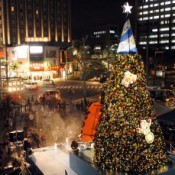
November 22, 2011 Ryukyu Shimpo
On the night of November 18, a Christmas tree-lighting ceremony was held in the event square of Palette-Kumoji in Naha by the three groups of the Palette-Kumoji, the Ryubo Department Store and Kokusai Street and Kencho-Mae Station Shopping District Association. The fantastic atmosphere of Christmas enveloped the town early in the festive season.
The crowd in the square raised a cheer as the countdown ended with the nine-meter tall tree lighting up.
A choir of children from the Zenrin Kindergarten set the mood for the event by singing before the countdown started.
Five year-old kindergarten pupil Yurika Higa smiled as she said,“ I was glad to be able to sing in front of the Christmas tree, but I was a little bit nervous.”
The Christmas tree will be in place until December 25.
(English translation by T&CT, Lima Tokumori and Mark Ealey)
Go To Japanese
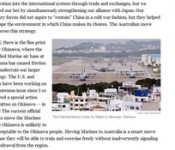
November 23, 2011 Ryukyu Shimpo
Former U.S. Assistant Secretary of Defense of the Clinton administration, Professor Joseph Nye supports the United States Government’s policy to move the U.S. Marine Corps to Australia. He is known as a key figure in the pro-Japanese group, and has been involved in the relocation of U.S. Marine Corps Futenma Air Station issue from about 15 years ago. Nye contributed an article entitled “A Pivot That Is Long Overdue” to the opinion pages of the New York Times (on its website) on November 21, in which he pointed out “The current official plan to move the Marines inside Okinawa is unlikely to be acceptable to the Okinawa people.” He also stated his support for the Obama Administration’s plan, saying, “Moving Marines to Australia is a smart move.”

Professor Joseph Nye
As a U.S. Assistant Secretary of Defense in 1995, he engaged himself in the “East Asia Strategy Report” known as the “Nye Initiative,” in which he advocated that the United States should maintain a total of 100000 troops in East Asia and emphasized the importance of the U.S. Marine Corps and other forces in Okinawa. As a professor at Harvard University after leaving the Clinton administration, he has a strong influence on U.S.-Japan’s security relations, including U.S. policy toward Japan.
With regard to moving the Marines to Australia to restrict China’s moves to increase its maritime interests, Nye suggested, “they will be able to train and exercise freely without inadvertently signaling a withdrawal from the region.”
On the Futenma Air Station, he pointed out, “There is the fine print about Okinawa, where the crowded Marine air base at Futenma has caused friction that undercuts our larger strategy,” and also added, moving the Marines to Australia “sends the right message to China, and avoids further friction with Japan.”
With regard to the U.S. Marine Corps being stationed in Australia, U.S. President Barack Obama showed this plan at his summit meeting with the Australian Prime Minister Julia Gillard, held on November 16. According to both governments, between 200 and 250 Marines will be deployed in there the middle of next year, and the number of Marines will be increased in stages, and their bilateral military exchanges will also be expanded. The United States will not construct its own base, but instead use existing military facilities in Australia. It also announced that it will extend the scale to 2500 Marines in the future.
Article by Professor Nye (Summary)
There are three good reasons for President Obama’s decision to rotate regularly 2,500 Marines through an Australian base. … Third, there is the fine print about Okinawa, where the crowded Marine air base at Futenma has caused friction that undercuts our larger strategy. The U.S. and Japan have been working on the Futenma issue since I co-chaired a special action committee on Okinawa — in 1995! The current official plan to move the Marines inside Okinawa is unlikely to be acceptable to the Okinawa people. Moving Marines to Australia is a smart move because they will be able to train and exercise freely without inadvertently signaling a withdrawal from the region.
(English Translation by T&CT, Mark Ealey)
Go To Japanese
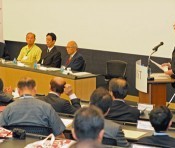
November 20, 2011 Ryukyu Shimpo
A ceremony to commemorate the establishment of the Okinawa Institute of Science and Technology Graduate University (OIST, President Jonathan Dorfan) was held at its main campus in Tancha, Onna Village on November 19.
The ceremony was attended by about 500 people including staff involved in the University, representatives from various organizations within Okinawa Prefecture and the Ministry of Education, Culture, Sports, Science and Technology, as well as from institutions of higher education both within Japan and overseas.
All involved hope that world-class study of science and technology and the education provided by OIST will contribute to the promotion of science and technology and the self-sustaining development of Okinawa.
Dorfan touched upon the outlook for OIST in his speech, saying, “We would like to continue contributing to the prefecture by offering education and carrying out research that employs world-class technology.”
Director of OIST Akito Arima offered some words of encouragement, saying, “I would like OIST to become a university that Okinawan people are truly proud of, and I hope that it stimulates the internationalization of the universities of Japan.”
Tatsuo Kawabata, State Minister in Charge of Okinawa Affairs, enthusiastically said, “Technology can make the dreams of the human race come true. I will strive to achieve the stated purpose of OIST and to facilitate the further development of Okinawa.”
Okinawa Governor Hirokazu Nakaima said, “I hope that OIST makes a great contribution to technological innovation initiated in Okinawa.”
Dr. Charles Vest, President Emeritus of the Massachusetts Institute of Technology, delivered the keynote speech, saying, “OIST is born and raised in Okinawa. It will bring huge benefits to Okinawa across the ages. OIST will also contribute to the world as a global agency in the era of globalization of knowledge.”
OIST is host to about 200 researchers from all around the world in preparation for launching the school in September 2012. It only offers a 5-year PhD program in science and accepts just 20 new students for each year group. OIST is notable for offering interdisciplinary research that defies the boundaries of particular fields.
(English Translation by T&CT, Mark Ealey)
Go To Japanese

Go To Video
November 23, 2011 Ryukyu Shimpo
A committee of five experts set up by the Okinawa Prefectural Government (OPG) and chaired by Professor Yoshifumi Ikeda of the University of the Ryukyus, held its second meeting on November 22 in which they drafted a description to be used on an explanation board for the former 32nd Army Headquarters Shelter at Shuri. Content will be finalized after the OPG considers the report in detail.
In 1997 the OPG created a plan to preserve and open the former Army Headquarter Shelter to the public, but since then concerns about safety issues have delayed progress. With heightened demand for such an explanation board, the OPG allocated about 2.15 million yen for this purpose in this year’s budget.
The committee’s report gives details of the history and construction of the Headquarters Shelter, the Japanese Army’s retreat to the south and the plight of those who lived in the shelter at the time of the battle. The committee members pointed out that the board should not only cover these facts, but should also include mention of the presence of female civilian personnel and of comfort women, that local people were killed by the Imperial Japanese Army without justification for supposedly being spies and that the retreat to the south by the military resulted in the death of many people. These suggestions by the committee members have been included in the report.
(English Translation by T&CT, Mark Ealey)
Go To Japanese
November 22, 2011 Ryukyu Shimpo
The Japanese and the U.S. governments are discussing granting Japan jurisdiction in cases of crime or incidents involving civilian employees of U.S. military in Japan that have occurred “in the line of duty” when the United States authorities have difficulty adjudicating.
However, these talks are aimed at improving the application of the current law by recognizing exceptions rather than revising the U.S.-Japan Status of Forces Agreement. But what both governments should do is revise the agreement to give the Japanese side jurisdiction in cases of crime or incidents that involve U.S. military personnel on duty. They should avoid making superficial changes to the agreement, which currently allows arbitrary interpretations that work to the advantage of U.S. citizens.
The agreement should be revised to grant the Japanese side jurisdiction in all cases of traffic accidents caused by U.S. military personnel and civilians who have consumed alcohol while “on duty.” This is the logical step to take. It is ludicrous in the extreme that accidents caused by U.S. military personnel and civilians driving under the influence of alcohol are overlooked.
Prime Minister Yoshihiko Noda has clearly stated, “We should immediately revise the old agreement.” While the Japanese and U.S. governments have begun to tackle the issue, their movements are too slow.
It is not clear what is meant by “cases that the United States authorities might have difficulty adjudicating over.” Many uncertainties hinder the way forward on this issue and this latest development can only be seen as a half step forward because the possibility still exists that the discretionary powers of the United States authorities could have priority over those of the Japanese side.
The fact that the Japanese side does not have jurisdiction in cases of crime or incidents involving U.S. military personnel and civilians on duty is a symbol of the inequality of the U.S.-Japan Status of Forces Agreement.
That the Japanese and U.S. governments have moved to tackle the issue is possibly due to the Okinawan people’s growing protests against the irrationality in both governments’ handling of a traffic accident caused by a U.S. military civilian employee on duty. In that case, an Okinawan man riding a motorcycle who had returned to the prefecture to attend his Coming-of-Age ceremony was hit by a car driven by a U.S. military civilian employee. The victim of the accident died this January, but because the U.S. military civilian employee driving the car was judged to have been “on duty” he was exempted from prosecution. The United States authorities went no further than imposing an administrative sanction on the man, suspending his driver’s license for a period of five years.
Of the 62 cases of crime or incidents involving U.S. military civilian employees in Japan that have occurred “in the line of duty” during the five-year period of 2006-2010, none have been brought to a court-martial, and 27 of those cases were processed as being not subject to punishment.
U.S. military civilian employees who have caused traffic accidents while on duty continue to live peaceful lives thanks to their exemption from prosecution both in Japan and the United States. The Japanese government bears a huge responsibility for having permitted this unacceptable double standard in favor of the United States to continue and for having left the irrationality of the law untouched.
Some U.S. military judge advocates have remarked that in their opinion, in times of peace the countries hosting U.S. military bases have exclusive jurisdiction over cases of crime committed by U.S. military civilian employees.
In South Korea, where crimes committed by U.S. military personnel stationed there show no sign of any significant decline, the number of the cases that the South Korean side has jurisdiction over is rapidly increasing.
The situation in South Korea in which the U.S. military is under pressure from public opinion to deal with the issues overlaps with the situation in Okinawa.
The people of Okinawa need to unite to exert pressure on both the Japanese and U.S. governments to drastically revise the U.S.-Japan Status of Forces Agreement.
(English Translation by T&CT, Mark Ealey)
Go To Japanese

November 22, 2011 Yukiyo Zaha of Ryukyu Shimpo
Tonaki Island has been selected for a block award in a public design contest organized by the Japan Urban Design Institute (JUDI). The award has been given for the beautiful landscape and foot-lights on Village Road No. 1.
Features of Tonaki Island include its coral limestone wall, its traditional wooden houses with red tile roofs surrounded by fukugi or common garcinia trees, and the white-sand paths. Almost all of the island has been designated as an important traditional building preservation area, but Tonaki faces issues such as the outflow of population and the aging of the community. Tonaki Island put the foot-lights in place between 2000 and 2005 as a part of the “Project to Promote Traditional Communities.”
Streetlights were replaced by foot-lights to allow greater enjoyment of the night sky and for safety purposes. A total of 152 footlights were placed several meters apart on the street that is 2 to 3 meters wide and 765 meters long.
According to the Village, the lights are turned on at dusk, from 6:00pm in winter and from 7:00pm in summer. The lights have given the dark and tranquil island a fantastic atmosphere.
Village Mayor Noboru Uehara said, “We hope to attract more tourists to the island.”
A spokesperson of the Economic Affairs Division of the village stated, “We want to make the most of this opportunity to let people know about the island and we want more people to come here.”
Other than Tonaki, 14 public designs were selected for awards including for the grand award.
(English Translation by T&CT, Shinako Oyakawa and Mark Ealey)
Go To Japanese
November 20, 2011 Ryukyu Shimpo
On November 19, the Cabinet Office finalized support measures through which the Japanese central government pays all of the cost for private organizations and municipalities to evacuate people unable to move by themselves in cases of unexploded ordnance disposal operations in Okinawa Prefecture.
The Cabinet Office expanded the eligibility for having bomb disposal costs covered.
Tatsuo Kawabata, the State Minister in Charge of Okinawa Affairs, who visited Okinawa on November 19, informed Okinawa Governor Hirakazu Nakaima of this during their meeting at Okinawa Institute of Science and Technology Graduate University.
Cases occurring in fiscal 2011 are also eligible for these measures, with the cost paid by the Ureshinogaoka-Samaritan Hospital when a U.S. military bomb found on the site of the hospital in the Arakawa District of Haebaru was disposed of in September being also included.
The government established the measures in order to safely evacuate people who are unable to evacuate by themselves mainly in cases when U.S. unexploded ordnance is disposed of on-site in hospitals and welfare institutions.
The government amended existing requirement guidelines, and had been investigating the situation based on requests from the municipalities following the case in Arakawa.
In cases of unexploded ordnance disposal operations, the costs incurred by private organizations and municipalities to evacuate people such as residents who need assistance from people other than family members, and residents receiving nursing care, can be covered by the support measures. Specifically, a.) cost of securing evacuation spaces and the installation and management of the spaces, b.) transporting evacuees to the spaces and c.) for staff needed for supporting evacuation, will be covered by the support measures. In addition, costs newly incurred by municipalities for evacuation beyond that for moving people unable to evacuate is also eligible to be covered.
Private organizations can apply through municipalities to utilize the measures and the total budget available for bomb disposal is about 1.6 billion yen. Costs incurred this fiscal year will be covered by the budget.
With regards to staff costs, only those for staff such as doctors and nurses employed at private organizations are eligible to be covered. The cost for staff employed by the prefecture and municipalities is estimated at eight million yen, and will be included in the approximately 2.3 billion yen requested for the next fiscal year. After his meeting with Kawabata, Nakaima said, “I am very pleased with these support measures. I thanked Minister Kawabata because I think that they will become permanent.”
(English Translation by T&CT, Mark Ealey)
Go To Japanese
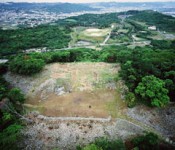
November 19, 2011 Ryukyu Shimpo
On November 18, the Cultural Affairs Council (headed by Suzuko Nishihara) asked Masaharu Nakagawa, the Minister of Education, Culture, Sports, Science and Technology (MEXT)
to designate the Shimashii-Ozato Castle Ruins of Ozato in Nanjo as an officially-designated historical site, and register the Nakamoto Garden of Ishigaki on Ishigaki Island as a national registered monument (sightseeing spot), at a separate meeting of the Council regarding cultural property. These will be the 36th officially designated historical site and the second registered monument in Okinawa Prefecture.
Shimashii-Ozato Castle Ruins is a gusuku (castle) that prospered as a residence of King Sannan in the Sanzan period (around the 14th to the 15th century). It is built of Ryukyu limestone on a hilly area, 150 meters (almost 500 feet) above sea level, and skillfully utilizes the natural contours ground. Inside the main building there is a place for worship, a well and a tomb of the Aji, who were the people in the ruling class at the time. The castle is highly valued both historically and academically because of its importance in assessing the process from the instability of the Sanzan period to the establishment of the Ryukyu Kingdom.
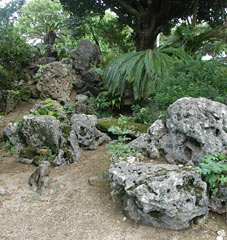
Nakamoto Garden at Ishigaki on Ishigaki Island has been registered as a national registered monument.
Nakamoto Garden, located in the grounds of a house in Yaeyama of the high warrior class under the administration of the Ryukyu Kingdom, is estimated to have been constructed in the middle of the 19th century. Constructed mainly from Ryukyu limestone and of the dry garden style, it is a valuable example of the spread of Japanese garden culture to Yaeyama.
(English Translation by T&CT, Lima Tokumori and Mark Ealey)
Go To Japanese
November 18, 2011 Ryukyu Shimpo
Okinawa Prefecture held the “Event in Shanghai to Promote the Second Anniversary of the Okinawa International Air Logistics Hub Project” over four days from November 17 to 20 in Shanghai, China.
About 100 representatives from companies in Okinawa were joined at the event by Okinawan Vice Governor Kanetoshi Yoseda.
On the first day of the event, the prefecture invited local Chinese companies to an Okinawa investment seminar designed to attract tourists and companies.
About 50 people from real-estate companies, investors and those involved with financial companies in China attended the event, listening attentively to the information from the prefecture.
Thirty of the people from business groups and prefectural staff, including Isao Oshiro, President of Bank of The Ryukyus and Yoshiaki Tamaki, President of the Bank of Okinawa, attended the event. They promoted the IT Shinryo Park, the IT Business Center in Uruma City, and the Okinawa Special Free Trade Zone, talking about the appeal and current situation of Okinawan tourism, and proposing investment in Nishihara Marine Town.
On the second day of the event, economic journalist Seiichi Takarabe gave a lecture titled “Resurgence, the growth potential of Japan,” followed by a discussion session. In addition exhibitions and markets could be viewed. On November 19, Okinawa Prefecture held a fair to promote Okinawan tourism and products. Some of the Okinawan representatives had a look at the Suzhou Bridal Project before the group returned to Okinawa on November 20.
(English Translation by T&CT, Mark Ealey)
Go To Japanese










 Webcam(Kokusai Street)
Webcam(Kokusai Street)


